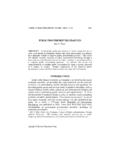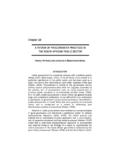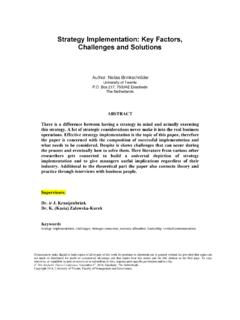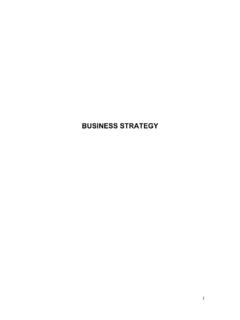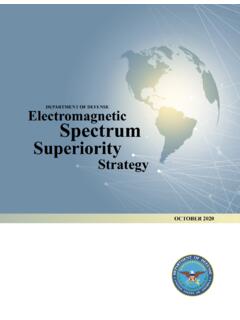Transcription of CRITICAL FACTORS THAT INFLUENCE E-PROCUREMENT ...
1 JOURNAL OF PUBLIC procurement , VOLUME 6, ISSUES 1 & 3, 70-99 2006 CRITICAL FACTORS that INFLUENCE E-PROCUREMENT implementation success IN THE PUBLIC SECTOR Kishor Vaidya, A. S. M. Sajeev and Guy Callender* ABSTRACT. This paper presents the results of a literature survey developed to support a proposed model of the CRITICAL success FACTORS (CSFs) likely to impact the success of E-PROCUREMENT initiatives in the public sector. It identifies a number of relevant variables for each CSF and presents a model for future research. It also analyses the relative importance of different CSFs and observes that organization and management FACTORS are the most important category for success of E-PROCUREMENT initiatives. If E-PROCUREMENT initiatives in the public sector are to assist the development of E-PROCUREMENT across the information economy, there should be wider discussion and agreement on what constitutes the relevant CSFs and how the achievement of success can be assessed.
2 INTRODUCTION A number of public sector agencies worldwide have identified Electronic procurement ( E-PROCUREMENT ) as a priority e-Government agenda and have implemented or are in the process of implementing buy-side E-PROCUREMENT systems. However, the scholarly evaluation of e- ------------------- * K. Vaidya and Sajeev, , are Candidate and Professor and Chair of IT and Computer Science, respectively, School of Mathematics, Statistics and Computer Science, University of New England, Australia. Mr Vaidya s research interests are in the domains of adoption, implementation , performance measurement of e-Commerce innovations, and public procurement . Dr. Sajeev s research interests are in the areas of Software Engineering and Web Engineering.
3 Dr. Callender is Foundation Professor and Chair of Leadership of Strategic procurement and, Editor-in-Chief of the Journal of Contemporary Issues in Business and Government, Curtin University of Technology, Australia. His research interests are procurement , the supply chain, supply market intelligence, and commercial history. Copyright 2006 by PrAcademics Press CRITICAL FACTORS that INFLUENCE E-PROCUREMENT implementation success 71 procurement initiatives, especially in relation to the use of CRITICAL success FACTORS (CSFs) in E-PROCUREMENT is very limited (Birks, Bond & Radford, 2001; DOF, 2001; CGEC, 2002; ECOM, 2002). A review of E-PROCUREMENT literature, primarily from the last five years, shows a lack of core constructs around CSFs. The reason for this might be that implementation of E-PROCUREMENT initiatives in the public sector is still in the early stages.
4 Tonkin (2003) argues there was little history of extensive use of E-PROCUREMENT in the public sector and, therefore, the academic literature covering early public sector adoption of E-PROCUREMENT is limited. This paper will assess the CSFs that are likely to INFLUENCE the success of E-PROCUREMENT initiatives in the public sector. The main overall objectives of the paper are to gain an exploratory understanding of E-PROCUREMENT issues in the public sector; to develop a conceptual framework that aids in identification of CRITICAL success FACTORS for adopting and implementing E-PROCUREMENT in the public sector; and to stimulate debate about the E-PROCUREMENT CSFs and the associated measures for success . Through a survey of the E-PROCUREMENT literature, this paper identifies eleven FACTORS : end-user uptake and training, supplier adoption, compliance with best practices for business case/project management, systems integration, security and authentication, re-engineering the process, top management support, performance measurement, change management, E-PROCUREMENT implementation strategy , and technological standards.
5 In the following sections, this paper discusses the background, requirements, and the barriers to E-PROCUREMENT implementation in the public sector. Following the methodological approach, each CSF is discussed in detail and a research model is presented. Finally, an analysis of the relative importance of the CSFs is presented and the paper concluded with a discussion on the differences and similarities of E-PROCUREMENT projects compared with traditional IT projects in the public sector. BACKGROUND What is E-PROCUREMENT ? Confusion exists in defining the term E-PROCUREMENT (Vaidya, Yu, Soar & Turner, 2003). While the terms E-PROCUREMENT and e-Purchasing have been used synonymously in many jurisdictions in an attempt to prove their involvement in the e-Commerce revolution (MacManus, 2002), the term purchasing has a 72 VAIDYA, SAJEEV & CALLENDER narrower scope.
6 E-PROCUREMENT refers to the use of Internet-based (integrated) information and communication technologies (ICTs) to carry out individual or all stages of the procurement process including search, sourcing, negotiation, ordering, receipt, and post-purchase review (Croom & Brandon-Jones, 2004). While there are various forms of E-PROCUREMENT that concentrate on one or many stages of the procurement process such as e-Tendering, e-Marketplace, e-Auction/Reverse Auction, and e-Catalogue/Purchasing, E-PROCUREMENT can be viewed more broadly as an end-to-end solution that integrates and streamlines many procurement processes throughout the organization. Although the term end-to-end E-PROCUREMENT is popular, industry and academic analysts indicate that this ideal model is rarely achieved (DOIR, 2001) and E-PROCUREMENT implementations generally involve a mixture of different models (S&A, 2003).
7 Although such end-to-end solutions offer robust and usually rich functionality, they are designed specifically to excel in just one or a few applications and thus pose various challenges (Cuthbert, Hamzic & Archer, 2003). Nevertheless, this paper will refer to the end-to-end E-PROCUREMENT system in order to avoid confusion but will not consider general email, electronic fax, voice communications, or non-Internet/Web based approaches, which are regarded as partial traditional E-PROCUREMENT solutions. As one of the core enablers of an e-Business supply chain, E-PROCUREMENT in this article is conceptualized as a subset of e-Commerce. While e-Commerce is simply a transaction conducted electronically, E-PROCUREMENT is the automation of many procurement processes via electronic systems, especially the Internet.
8 Having defined E-PROCUREMENT for the purpose of this paper, it is also important to also define the term implementation . What is implementation ? As with E-PROCUREMENT , implementation has been defined in different ways. A typical general definition from the Information Systems (IS) literature, states that implementation is an effort beginning with the first thought of developing a system and not ending until the project is completed or abandoned (Ginzberg, 1979, p. 408). Chan and Swatman (1998), however, state that IS implementation is best described as a process of organizational change that extends over a considerable period of time. More recent definitions of the term stem from the diffusion-based models of innovation adoption in relation to e-Commerce/e-Business (Srinivasan, Lilien & Rangaswamy, 2002).
9 Cooper and Zmud (1990) propose a five-stage framework of initiation, CRITICAL FACTORS that INFLUENCE E-PROCUREMENT implementation success 73 adoption, acceptance, routinization, and infusion explaining how an IT solution (application) is implemented in organizations, which, with the exception of infusion, forms the framework of this analysis. Infusion is the stage at which the E-PROCUREMENT solution is used within the organization to its full potential. As most E-PROCUREMENT initiatives are in their infancy, this sort of approach will guide the selection of some E-PROCUREMENT initiatives in the public sector and identify the most relevant CSFs for the purpose of this study. Over the last 40 years, while private and public sector organizations have been utilizing Information Technology (IT) systems to streamline and automate their purchasing and other processes, it is only in the past decade that E-PROCUREMENT systems have attracted attention.
10 While there is debate about how recently E-PROCUREMENT has emerged. (Dai & Kauffman, 2001; Koorn, Smith & Mueller, 2001), there is no doubt that the use of the Internet in E-PROCUREMENT provides several advantages over earlier inter-organizational tools. For example, Electronic Data Interchange has been providing automated purchasing transactions between buyers and their suppliers since it was launched in the 1960s. Enterprise Resource Planning (ERP) followed in the 1970s, and then came the commercial use of the Internet in 1980s. It was only in the 1990s that the World Wide Web - the multimedia capability of the Internet - became widely enabled and provided the essential resource for the automation of procurement (OGC, 2002). According to Koorn, Smith and Mueller (2001), there are three types of E-PROCUREMENT Systems: Buyer E-PROCUREMENT Systems, Seller E-PROCUREMENT Systems and Online Intermediaries.
